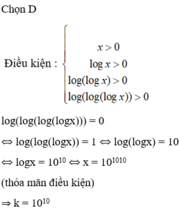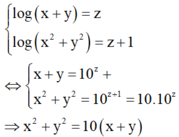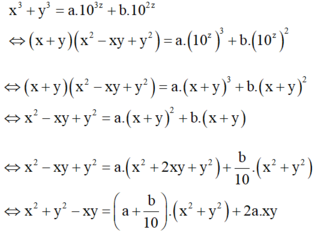Hãy nhập câu hỏi của bạn vào đây, nếu là tài khoản VIP, bạn sẽ được ưu tiên trả lời.

Đáp án B
Ta có log(x + 2y) = log x + log y
<=> log 2 (x+2y) = log 2xy
<=> 2 (x+2y) = 2xy (*).
Đ ặ t a = x > 0 b = 2 y > 0 , khi đó
* ⇔ 2 a + b = a b
và P = a 2 1 + b + b 2 1 + a ≥ a + b 2 a + b + 2
Lại có a b ≤ a + b 2 4 ⇒ 2 a + b ≤ a + b 2 4 ⇔ a + b ≥ 8 .
Đặt t = a + b, do đó
P ≥ f t = t 2 t + 2 .
X é t h à m s ố f t = t 2 t + 2 t r ê n [ 8 ; + ∞ )
c ó f ' t = t 2 + 2 t t + 2 2 > 0 ; ∀ ≥ 8
Suy ra f(t) là hàm số đồng biến trên [ 8 ; + ∞ )

Vậy gía trị nhỏ nhất của biểu thức P là 32 5 .

\(a^2+4b^2=23ab\Rightarrow a^2+4ab+4b^2=27ab\Rightarrow\left(a+2b\right)^2=27ab\)
\(\Rightarrow\dfrac{\left(a+2b\right)^2}{9}=3ab\)\(\Rightarrow\left(\dfrac{a+2b}{3}\right)^2=3ab\)
Lấy logarit cơ số c hai vế:
\(log_c\left(\dfrac{a+2b}{3}\right)^2=log_c\left(3ab\right)\)
\(\Rightarrow2log_c\dfrac{a+2b}{3}=log_c3+log_ca+log_cb\)
\(\Rightarrow log_c\dfrac{a+2b}{3}=\dfrac{1}{2}\left(log_ca+log_cb+log_c3\right)\)

Bài 1:
\(A=\log_380=\log_3(2^4.5)=\log_3(2^4)+\log_3(5)\)
\(=4\log_32+\log_35=4a+b\)
\(B=\log_3(37,5)=\log_3(2^{-1}.75)=\log_3(2^{-1}.3.5^2)\)
\(=\log_3(2^{-1})+\log_33+\log_3(5^2)=-\log_32+1+2\log_35\)
\(=-a+1+2b\)
Bài 2:
\(\log_{30}8=\frac{\log 8}{\log 30}=\frac{\log (2^3)}{\log (10.3)}=\frac{3\log2}{\log 10+\log 3}\)
\(=\frac{3\log (\frac{10}{5})}{1+\log 3}=\frac{3(\log 10-\log 5)}{1+\log 3}=\frac{3(1-b)}{1+a}\)

Lời giải:
Đặt \(\left\{\begin{matrix} \log_ab=x\\ \log_bc=y\\ \log_ca=z\end{matrix}\right.\Rightarrow \left\{\begin{matrix} \log_ba=\frac{1}{x}\\ \log_cb=\frac{1}{y}\\ \log_ac=\frac{1}{z}\end{matrix}\right. \). và \(xyz=1\)
Do \(a,b,c>1\Rightarrow x,y,z>0\)
Ta có:
\(P=\log_a(bc)+\log_b(ac)+4\log_c(ab)\)
\(=\log_ab+\log_ac+\log_ba+\log_bc+4\log_ca+4\log_cb\)
\(=x+\frac{1}{z}+\frac{1}{x}+y+4z+\frac{4}{y}\)
Áp dụng BĐT Cô-si cho các số dương:
\(\left\{\begin{matrix} x+\frac{1}{x}\geq 2\sqrt{1}=2\\ y+\frac{4}{y}\geq 2\sqrt{4}=4\\ \frac{1}{z}+4z\geq 2\sqrt{4}=4\end{matrix}\right.\) \(\Rightarrow P\geq 2+4+4=10\)
\(\Rightarrow m=10\)
Dấu bằng xảy ra khi \(\left\{\begin{matrix} x=\frac{1}{x}\rightarrow x=1\\ y=\frac{4}{y}\rightarrow y=2\\ \frac{1}{z}=4z\rightarrow z=\frac{1}{2}\end{matrix}\right.\) (thỏa mãn)
Suy ra \(n=\log_bc=y=2\)
\(\Rightarrow m+n=12\)

ĐKXĐ: \(x\ne y\)
\(log_xy=\frac{1}{log_xy}\Leftrightarrow log_x^2y=1\Leftrightarrow\left[{}\begin{matrix}log_xy=1\\log_xy=-1\end{matrix}\right.\) \(\Rightarrow\left[{}\begin{matrix}x=y\left(l\right)\\x=\frac{1}{y}\end{matrix}\right.\)
\(log_x\left(x-\frac{1}{x}\right)=log_{x^{-1}}\left(x+\frac{1}{x}\right)\Leftrightarrow log_x\left(x-\frac{1}{x}\right)=-log_x\left(x+\frac{1}{x}\right)\)
\(\Leftrightarrow log_x\left(x-\frac{1}{x}\right)\left(x+\frac{1}{x}\right)=0\Leftrightarrow\left(x-\frac{1}{x}\right)\left(x+\frac{1}{x}\right)=1\)
\(\Leftrightarrow x^2-\frac{1}{x^2}=1\Leftrightarrow x^4-x^2-1=0\Rightarrow x^2=\frac{1+\sqrt{5}}{2}\Rightarrow y^2=\frac{1}{x^2}=\frac{-1+\sqrt{5}}{2}\)
\(\Rightarrow x^2+xy+y^2=\frac{1+\sqrt{5}}{2}+1+\frac{-1+\sqrt{5}}{2}=\sqrt{5}+1\)

\(log_xy=log_yx=\frac{1}{log_xy}\Rightarrow\left(log_xy\right)^2=1\Rightarrow\left[{}\begin{matrix}log_xy=1\\log_xy=-1\end{matrix}\right.\)
\(\Rightarrow\left[{}\begin{matrix}x=y\\x=\frac{1}{y}\end{matrix}\right.\)
Do \(log_x\left(x-y\right)\) tồn tại \(\Rightarrow x-y\ne0\Rightarrow x\ne y\Rightarrow x=\frac{1}{y}\)
\(log_x\left(x-y\right)=log_y\left(x+1\right)\Leftrightarrow log_x\left(x-\frac{1}{x}\right)=-log_x\left(x+1\right)\)
\(\Leftrightarrow log_x\left[\left(x-\frac{1}{x}\right)\left(x+1\right)\right]=0\Leftrightarrow\left(x-\frac{1}{x}\right)\left(x+1\right)=1\)
\(\Leftrightarrow\left(x^2-1\right)\left(x+1\right)=x\Leftrightarrow x^3+x^2-2x-1=0\)
Pt này nghiệm xấu, đề bài có vấn đề








Đáp án C